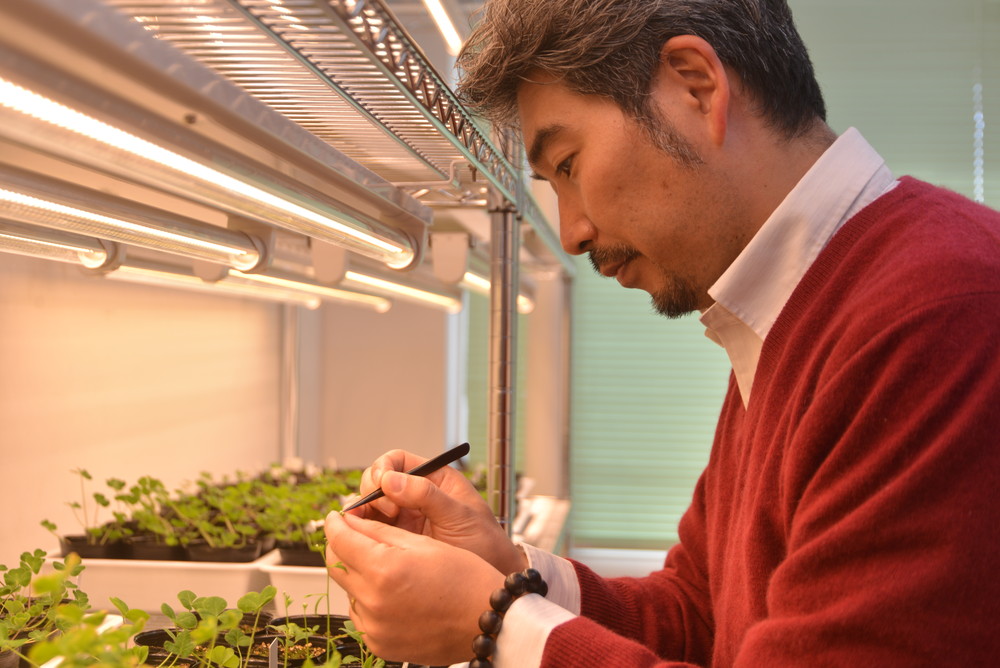NEWS
IROAST Researchers - Assoc. Prof. Masahiko Furutani
English Japanese
Roots, soil environment, and microorganisms
Pursuing the triangular network mechanism

Associate Professor Masahiko FURUTANI
International Research Organization for Advanced Science and Technology (IROAST)
(Period at IROAST: from August 2022-March 2024)
Associate Professor Masahiko Furutani has been studying the interaction between plant roots and the soil environment at the molecular and cellular levels even before being appointed to IROAST. After joining IROAST, a study on the mechanism of infection with soil microorganisms, plant-parasitic nematodes, began in addition to the study of roots and the soil environment.
■ “Plant movement,” his interest since childhood. Initiating a study with the objective of agricultural damage mitigation
Q: Can you please tell us about your research?
Furutani: I am studying the mechanism of interaction between plant roots, microorganisms, and the underground soil environment.
Before joining IROAST, I was studying plant roots and soil environment at Fujian Agriculture and Forestry University in Fujian Province, China. Specifically, I was studying the reaction of plant roots to high concentration of salt in soil using a model plant Arabidopsis thaliana. For example, if there is salt in soil, roots basically grow to avoid the salt. Why does such a reaction occur? I was studying its mechanism.
After joining IROAST, I have also included the impact of microorganisms in the study. These are microorganisms called nematodes that infect and damage plants.
Though the research topics are diverse, one of them is to elucidate the infection mechanism of plants by nematodes. Once they penetrate into plant roots, nematodes find cells and stick a needle in them to change the property of these cells to absorb nutrients. Though nematodes create several cells that appear to be cancerized, what they are and what mechanism causes this are still unknown. If root vegetables are parasitized, they cannot be marketed. If we understand the nematodes' mechanism for changing plant cells, we can create crops that do not react to their needles. We are studying this topic so that we can reduce agricultural damage.

Q: What motivated the present study?
Furutani:I was interested in plant movement even as a young child; especially, the cause for plants to grow in the direction of light. In elementary school, I did a science project on this topic.
At university, I joined a botany laboratory and began research in earnest. The first research topic was why roots can grow toward gravity. Even if placed horizontally, plant roots grow downward. I was studying to elucidate this mechanism. During that study, I wondered if there is anything other than gravity that had an impact and focused on salt.
Plant roots are attracted to gravity but avoid salt. I began my study to find out the mechanism roots use for avoiding salt, and genes that regulate the direction of root growth. I have been continuing this study even after joining IROAST. I am wondering if we could grow crops that avoid salt well, or halophytic plants that move toward salt.

■ Grateful for the space. IROAST offers an environment that allows focus on research
Q: What do you like about IROAST?
Furutani: Research support is extensive. I am grateful for all their support. Their assistance with academic papers is amazing. Furthermore, I find their large research space helpful. It is easier to focus on research when you have your own space. It is also extremely helpful that there is ample support for start-ups immediately after the appointment, including funding.
Moreover, I am discussing with an American professor about starting an international research cluster. IROAST has a support system for international research cooperation, which I hope to utilize.
Q: What is your outlook?
Furutani: I have known Professor Shinichiro Sawa of the Faculty of Advanced Science and Technology (FAST) and Professor Mitsuhiro Aida (former tenure track faculty member at IROAST) for a long time. Since we are at the same university now, I hope we can achieve new discoveries. I am also affiliated with the International Research Center for Agricultural & Environmental Biology, where Professor Sawa is the manager, with whom I am working on agricultural research. With Professor Shintaro Ida and Professor Shinya Hayami of the Institute of Industrial Nanomaterials, Kumamoto University, I am studying the use of graphene oxide, a nanomaterial, as a soil conditioner.
In the past, I conducted basic scientific research in the laboratory, but since I arrived in Kumamoto Prefecture, I find its proximity to agricultural fields to be an advantage. I occasionally visit Kumamoto Agricultural Research Center, and I am scheduled to start agricultural training for students. New ideas emerge while in the field and connecting with people. This has increased since I came to Kumamoto.
In China, I began research on a super food, quinoa, and I am still continuing with the study. Plants break down the starch stored in the endosperm and use it as nutrients to germinate but quinoa stores starch in a different place than other plants. I am studying the mechanism quinoa utilizes to break down and use starch. Quinoa is very resistant to salt. In fact, quinoa does better with salt in the soil. I hope to clarify this mechanism as well.

■ Kumamoto: a peaceful like with family surrounded by nature
Q: How is life in Kumamoto?
Furutani: I spend my days off with my family. I love how close we are to nature. I have visited Tatsudayama with my child many times thus far. I think it is the hardest for my child since his living environment and schools have changed many times with my transfer. However, he seems to have adapted to Kumamoto very well.
Related link
- IROAST Staff - Tenure-track Associate Professor

